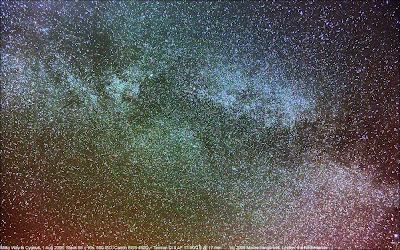The Tamron lens needs to be focussed using the "live view" function of my camera (Canon EOS 450D), as it has no "hard stop" at infinity, like most modern lenses.
I ran into trouble though. Pointed it to Arcturus but no star to be seen on the screen whatever I tried. Dito with Vega, Deneb. Frustration! Then worry. Was my camera malfunctioning?!?
I looked up. And saw a bright IGS 1B majestically sail accross the sky. Grrr!
I took the camera again. And then the quarter finally fel....
Yep: forgotten to take off the lens cover....
* bangs head against desk repeatedly *
Later that evening I made a series of images with the 450D camera + Tamron lens piggyback on my ETX-70 telescope. 69 frames of 10 second exposure each at 800 ISO and 17mm/F2.8 were stacked into this image of the Milky Way in Cygnus, mimicking a 11.5 minute exposure:
(click image to enlarge)

Difficult to believe for me too that this was obtained right from a town center, but nevertheless it is true! Stacking large numbers of short exposure images makes this possible.
1 comment:
First of all: Thanks for this interesting blog. It keeps reminding me to look up more!
What magnitude was IGS 1B last night? I don't think it is in the heavens-above.com database.
What is your approx cut-off magnitude for visual viewing of satelites? (In Leiden city)?
Post a Comment